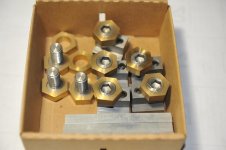rons
Diamond
- Joined
- Mar 5, 2009
- Location
- California, USA
Box is 16W 20H and 8D, W - width, H - height, D - depth
The steel is 0.075 thick. I want to cut slots on the sides. The box would have to laid on it's opposite side.
The issue is the 16" height. I am thinking of using these cam locks I made a few years ago.


Experience says that the top panel of the box will be free enough to cause chatter. I dread the thought of doing these slots by hand.
The drill press I own is really for wood and the slowest speed can burn up a large cobalt drill bit. I have a spare 3 HP VFD and a 1 Hp 3 phase motor
that I can alter the drill press with but I would rather not do that yet. Even if that worked there would be a lot of filing.
Ideal situation is to lower a 1/2" cutter into the sheet and go 3" and turn 90 degrees, keep doing this until start position. Want to do this 4 per side.
The steel is 0.075 thick. I want to cut slots on the sides. The box would have to laid on it's opposite side.
The issue is the 16" height. I am thinking of using these cam locks I made a few years ago.


Experience says that the top panel of the box will be free enough to cause chatter. I dread the thought of doing these slots by hand.
The drill press I own is really for wood and the slowest speed can burn up a large cobalt drill bit. I have a spare 3 HP VFD and a 1 Hp 3 phase motor
that I can alter the drill press with but I would rather not do that yet. Even if that worked there would be a lot of filing.
Ideal situation is to lower a 1/2" cutter into the sheet and go 3" and turn 90 degrees, keep doing this until start position. Want to do this 4 per side.
Last edited:




